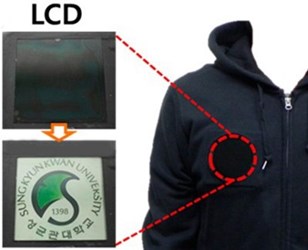Energy-Generating Textile To Deliver Battery-Free Power To Wearable Devices

A team of Korean scientists have designed a textile capable of harnessing energy from human motion to power wearable devices without an external power source. The cloth is durable, flexible, and lightweight, making it an ideal candidate for wearable medical device applications.
The design is based on triboelectric nanogenerator (TNG) technology and incorporates a silver-coated textile, nanorods, and a silicon-based organic material. Slight finger pressure applied to the four stacked layers of the material provided enough energy to power light sources, liquid crystal displays (LCDs), and a keyless entry remote for 12,000 cycles, the scientists said in an American Chemical Society press release.
A study led by Sang-Woo Kim and published in ACS Nano reported that, “A high output voltage and current of about 120 V and 65 μA, respectively, were observed from a nanopatter.”
The textile is fully flexible and foldable, say the scientists, which demonstrates its potential for use in robotic skin or other biomedical device applications. Furthermore, the material can self-charge batteries and supercapacitors.
Wearable medical devices are only as convenient as their power sources, say the scientists, and a bulky or stiff battery or an external plug can severely inhibit a product’s versatility.
Triboelectrification is an energy-harnessing method based on the principles of static electricity. According to Zhong Lin Wang, a professor at Georgia Tech and a specialist in triboelectric nanogenerators, the technology has shown great promise in powering battery-free devices and can be designed using a number of different materials.
“There are numerous ways to enhance the performance of the triboelectric nanogenerator from the materials point of view” Wang said in a report published by ACS Nano. “This gives an excellent opportunity for chemists and material scientists to do extensive study both in the basic science and in practical applications.”
This week, a collaborative team of scientists from the Beijing Institute of Nanoenergy and Nanosystems, the Chinese Academy of Science, the University of Washington, and the Georgia Institute of Technology published a study in Advanced Materials introducing a self-charging power unit that incorporated textile triboelectric nanogenerator into a flexible lithium-ion battery.
Last month, a team of scientists from the National University of Singapore introduced a system of wearable sensors also based on triboelectric nanogenerator technology, which used gold-plating. Their device could generate 90 volts of open circuit voltage when subjected to finger pressure.
A Transparency Market Research (TMR) report released last December estimated that the global wearable medical device market was worth $2 billion in 2012, a number expected to triple to $5.8 billion by 2019.
Though the 2012 wearable medical device market was dominated by North America, the TMR report projected that the Asia-Pacific market would be the fastest growing.
Image credit: American Chemical Society
